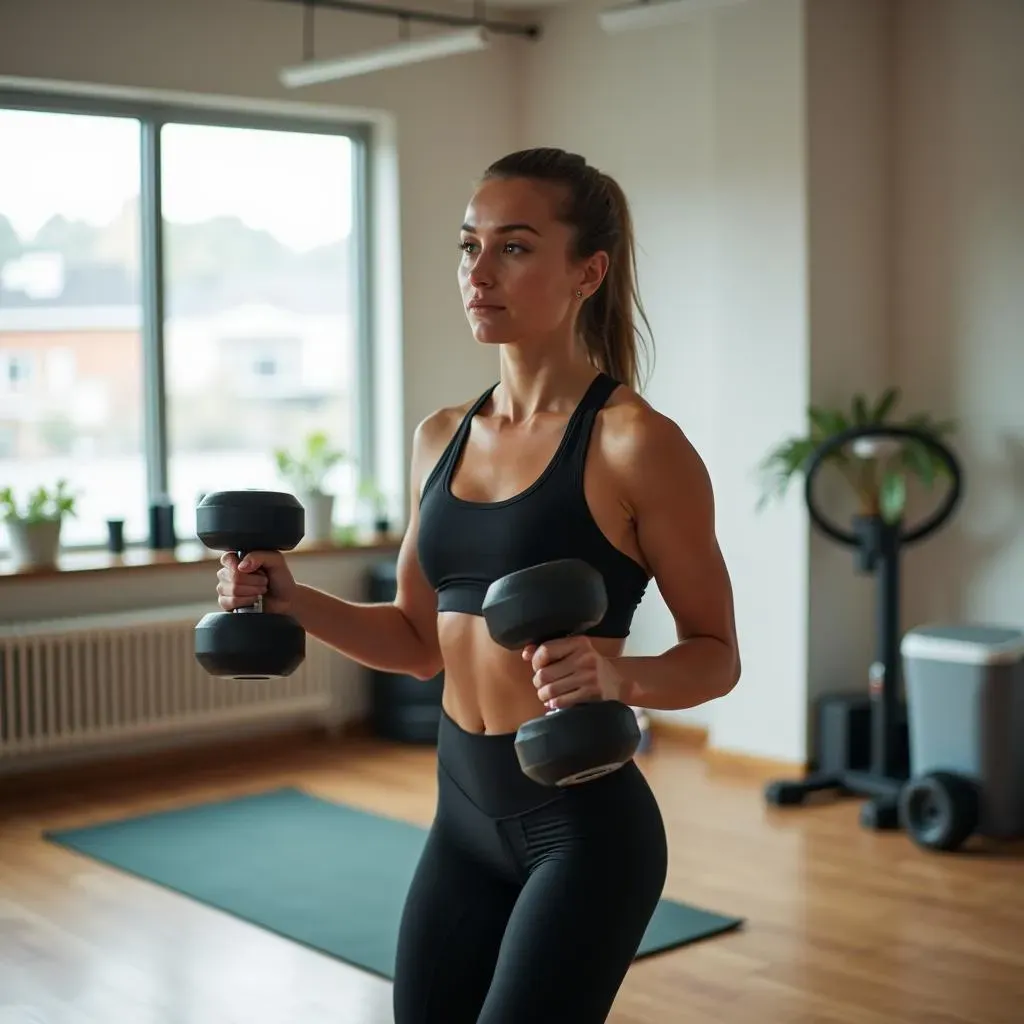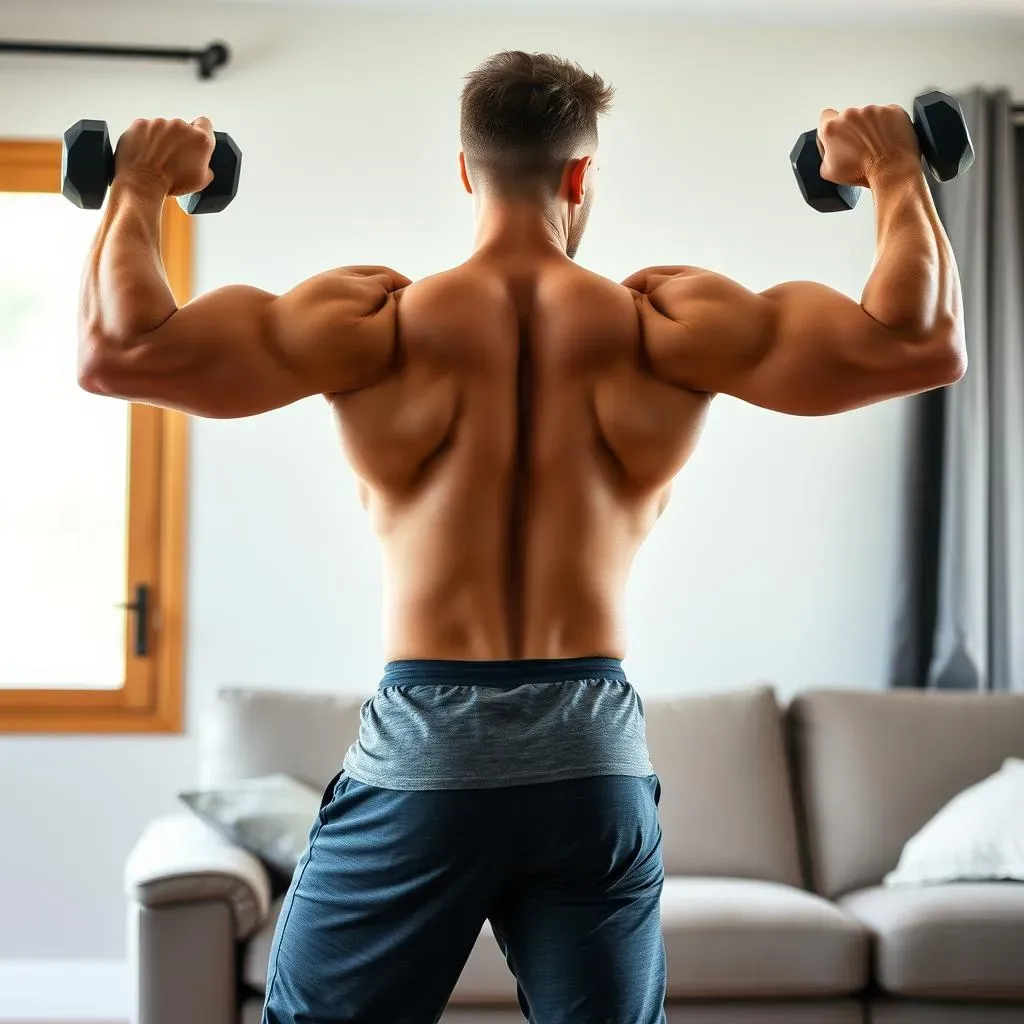Table of Contents
Ever feel like your back is screaming at you after a long day? Or maybe you just want to look like you can lift a car? Either way, you're in the right place. We’re diving into why back workouts at home with dumbbells are a total game-changer. It's not just about looking good, it’s about feeling good, moving better, and being stronger. Think of your back as the unsung hero of your body, it's the foundation for everything. This article will walk you through why you should care about those back muscles, which ones are the key players, and how to target them with dumbbells. We will cover the benefits of using dumbbells for your back exercises, and how to properly warm up before getting started. Finally, I'll break down the 10 best dumbbell exercises for your back, so you can build a stronger, healthier you, right in your living room, no gym membership required. So, grab your dumbbells and let's get started!
Why Should You Train Your Back Muscles?

Why Should You Train Your Back Muscles?
The Foundation of Strength
Okay, let’s get real, your back isn’t just some slab of meat holding up your shirt. It’s the core of your entire body. Seriously, think about it. Your back muscles are like the foundation of a house. If that foundation is weak, the whole thing is shaky. If you want to be able to lift, twist, and move without feeling like you're going to snap in half, a strong back is non-negotiable. It’s the silent workhorse behind almost every move you make.
I used to ignore my back, focusing only on the mirror muscles (chest, biceps, you know the drill). Then I tried to help a friend move a couch, and well, let’s just say my back had a strong opinion about that. Now, I treat my back like the VIP it is.
Posture and Pain Relief
Ever see someone slouching like a question mark? Yeah, that's often a sign of a weak back. When your back muscles aren’t up to the task, your posture suffers and you might start to feel aches and pains in the neck, shoulders, and even the lower back. Strengthening those back muscles helps you stand tall, which not only looks better but can also alleviate a lot of discomfort. It's like giving your spine a built-in support system.
Trust me, your future self will thank you for not spending your days hunched over a keyboard like a goblin. Plus, who doesn't want to walk around feeling like a superhero?
Benefit | Description |
|---|---|
Improved Posture | Strengthens muscles that support the spine, reducing slouching. |
Reduced Pain | Alleviates discomfort in the neck, shoulders, and lower back. |
Enhanced Movement | Improves your ability to lift, twist, and move with ease. |
Everyday Life Enhancer
Think about all the things you do every day. Carrying groceries, lifting boxes, playing with your kids, or even just sitting at your desk. All those things rely on your back muscles. When your back is strong, these everyday activities become easier, and you feel more resilient. It’s not just about the gym; it's about making your whole life better. A strong back helps prevent injuries and makes you more capable in all aspects of your daily routine.
It's like upgrading your car's engine; everything else just runs smoother. So, don't just train for the sake of training, train for the sake of living a better life!
What Are the Key Muscles in Your Back (And How to Target Them)

What Are the Key Muscles in Your Back (And How to Target Them)
Meet Your Back's A-Team
Alright, let’s get down to the nitty-gritty and talk about the superstars of your back. It's not just one big blob of muscle back there; it's a whole crew working together. You've got the latissimus dorsi (or "lats"), those big wing-like muscles that give you that V-shape. They’re the powerhouses for pulling movements. Then there are the trapezius (or "traps"), which run from your neck down to the middle of your back, they help with shoulder movement and stability. The rhomboids sit between your shoulder blades and help pull them back, crucial for good posture. And don't forget the erector spinae, these run along your spine and keep you upright. Finally, the multifidus are tiny muscles that stabilize your spine, deep beneath the erectors. Each of these muscles plays a crucial role, and targeting them effectively means a stronger, healthier back.
It’s like having a well-coordinated sports team; everyone has their role, and when they work together, you get amazing results. Think of your back muscles as teammates, each vital for different actions but all contributing to the overall strength and stability of your body.
Targeting the Right Muscles
Okay, so knowing the muscles is one thing, but how do we actually make them work? Well, for the lats, think about movements like rows and pull-ups. These exercises really make them fire up. The traps respond well to shrugs and rows, especially when you focus on squeezing your shoulder blades together. For the rhomboids, exercises like face pulls and rows where you really pull your shoulder blades back are key. Exercises like deadlifts and good mornings are fantastic for the erector spinae, while exercises that involve spinal rotation and extension will engage the multifidus. The trick is to use a variety of exercises, and really focus on the movement, not just lifting the weight. It’s like learning a new dance – you need to know the steps to move smoothly.
Remember, it's not just about lifting heavy; it's about moving with intention and feeling the muscles contract. I've found that slowing down my reps and focusing on the squeeze at the top of each move makes a huge difference in muscle activation. It’s like having a conversation with your muscles; you need to pay attention to what they’re telling you.
Muscle Group | Function | Target Exercises |
|---|---|---|
Latissimus Dorsi (Lats) | Pulling movements, arm adduction | Rows, pull-ups, lat pulldowns |
Trapezius (Traps) | Shoulder movement, stability | Shrugs, rows, face pulls |
Rhomboids | Retraction of scapula | Rows, face pulls, rear delt flys |
Erector Spinae | Spinal extension, posture | Deadlifts, good mornings, back extensions |
Multifidus | Spinal stability | Bird dogs, rotational exercises |
The Benefits of Doing Dumbbell Back Exercises

The Benefits of Doing Dumbbell Back Exercises
Why Dumbbells are Your Back's Best Friend
So, you're probably wondering, why dumbbells? Well, let me tell you, they're not just for bicep curls. Dumbbells are like the Swiss Army knives of the fitness world, especially when it comes to back workouts. They’re super convenient, you can use them at home, no fancy gym equipment needed. Unlike machines that lock you into a specific movement, dumbbells allow for a more natural range of motion, which is great for building functional strength. Plus, they let you work each side of your body independently. This is called unilateral training, and it's fantastic for fixing any strength imbalances you might have. If one side of your back is weaker, dumbbells will make sure that side has to catch up. It's like having a personal trainer that's always watching, making sure you're not slacking on either side.
I remember when I started using dumbbells for my back, I was surprised at how much more I could feel the muscles working. It's like they add that extra level of challenge and control that you just don't get with other equipment. And honestly, who doesn’t love the feeling of a good workout from the comfort of their own home?
More Muscle, Less Hassle
Dumbbells are also great for progressive overload, which is a fancy way of saying you can gradually increase the weight as you get stronger. This is how you build muscle and get those gains. You can start light, and as you get stronger, just grab heavier dumbbells. It’s like leveling up in a video game; you're constantly pushing yourself to improve. Also, dumbbell exercises can target specific back muscles more effectively. For example, a dumbbell row can really hone in on your lats, while a reverse fly can work your rhomboids and traps. This allows you to tailor your workouts to your specific goals and needs.
And let’s be honest, who has time to spend hours at the gym? With dumbbells, you can get a super effective back workout in just 30 minutes, right at home. It’s like having a gym in your closet, always ready when you are. Plus, you don’t have to deal with gym bros hogging the equipment.
- Convenience: Work out at home.
- Natural Range of Motion: Better for functional strength.
- Unilateral Training: Fix strength imbalances.
- Progressive Overload: Easily increase weight.
- Targeted Workouts: Focus on specific muscles.
- Time-Saving: Effective workouts in less time.
How to Warm Up Your Back Before Training

How to Warm Up Your Back Before Training
Why Warming Up is Non-Negotiable
Alright, before you start throwing around those dumbbells, let’s talk about something super important: warming up. Think of your back as a finely tuned engine. You wouldn't start a car in the dead of winter and immediately floor it, would you? No way! Same goes for your back. Jumping straight into heavy lifting without a proper warm-up is like asking for trouble. It’s like trying to fold a cold piece of paper, it just crumbles. You need to get the blood flowing, loosen up those muscles, and prepare your body for the workout ahead. A good warm-up not only prevents injuries but also improves your performance. It’s about getting your body ready to work, not just showing up to the workout.
I know, I know, sometimes warming up feels like a chore. I've been there, wanting to just jump right into the action. But trust me, taking those extra few minutes to warm up makes all the difference. It’s like giving your body a little pep talk before the main event. It’s not a waste of time, it’s an investment in your workout. So, let's get those muscles ready to rock!
Dynamic Stretches and Light Cardio
So, what does a good back warm-up look like? Forget about static stretches where you hold a position for ages, we need to get moving! Start with some light cardio, like a few minutes of brisk walking or jumping jacks, just enough to get your heart rate up a bit. Then, move onto dynamic stretches. These are movements that take your joints through a full range of motion. Think arm circles, torso twists, cat-cow stretches, and leg swings. These movements help to increase blood flow to your muscles, improve flexibility, and get your joints ready for action. Don't rush these, focus on controlled movements. It’s like giving your body a gentle wake-up call, letting it know it’s time to get going.
I like to imagine my muscles waking up, yawning, and stretching out like a cat in the morning. It makes the process way more fun. Remember, the goal isn't to tire yourself out, it’s to prepare your body for the workout. So keep it light, keep it moving, and get ready to rock those dumbbell exercises. It is like lubricating the hinges on a door before you start swinging it open and closed.
Warm-Up Component | Examples | Benefits |
|---|---|---|
Light Cardio | Brisk walking, jumping jacks | Increases heart rate, improves blood flow |
Dynamic Stretches | Arm circles, torso twists, cat-cow | Increases flexibility, prepares joints |
The Best Dumbbell Back Exercises

The Best Dumbbell Back Exercises
Dumbbell Bent-Over Row: The King of Back Builders
Alright, let's get into the good stuff – the exercises! First up, we have the dumbbell bent-over row. This is like the bread and butter of back workouts, hitting almost every muscle in your back. You'll want to stand with your feet shoulder-width apart, hold a dumbbell in each hand, and hinge at your hips, keeping your back straight. Then, pull the dumbbells up towards your chest, squeezing your shoulder blades together. It's like you're trying to pinch a pencil between your shoulder blades. It might feel a little awkward at first, but trust me, once you get the hang of it, you'll love it. This exercise is fantastic for building overall back strength and is a great starting point for any dumbbell back workout.
I remember the first time I tried these, I felt like a rusty hinge. But after a few weeks, I could feel my back getting stronger and more stable. It’s amazing how consistent effort can make a huge difference. Just make sure you're not rounding your back, keep it nice and straight. Imagine you're a table, you wouldn't want your tabletop to be sagging, would you?
Superman and Good Mornings: Strengthening the Posterior Chain
Next, let’s talk about the Superman and Good Mornings, two fantastic moves that work your lower back and glutes. For the Superman, lie face down on the floor, arms extended forward, and legs straight. Then, lift your arms, chest, and legs off the ground, squeezing your lower back and glutes. You'll feel like you're flying, hence the name. It’s like a full-body back extension, great for strengthening your lower back muscles. Good Mornings are another great exercise for the lower back and hamstrings. Stand with feet shoulder-width apart, hold a dumbbell across your upper back, and hinge at the hips, keeping your back straight. It’s like a bow, you're bending forward, stretching your hamstrings, and strengthening your lower back. It’s a bit tricky at first, so start with light weight and focus on the movement.
These exercises are often overlooked, but they're crucial for building a strong and stable back. I used to think that only heavy lifts mattered, but these bodyweight moves have made a huge difference in my back strength and stability. It is like adding support beams to your house, you might not see them all the time but they are important.
"The only way to do great work is to love what you do." - Steve Jobs
Renegade Row and Romanian Deadlift: Adding Variety and Challenge
Now, let’s add some variety with the Renegade Row and Romanian Deadlift (RDL). The Renegade Row is a plank with a twist. Get into a plank position, with a dumbbell in each hand, then row one dumbbell up towards your chest, while keeping your body stable. This move works your core, back, and shoulders, all at once. It is like a full-body workout disguised as a back exercise. The RDL is a fantastic exercise for your hamstrings, glutes, and lower back. Stand with feet shoulder-width apart, holding a dumbbell in each hand. Then, hinge at the hips, lowering the dumbbells towards the ground, keeping your back straight. It’s like you're bowing, but with a focus on your hamstrings and lower back. It is a great way to build strength and power in your posterior chain.
These two exercises are a real game-changer for my back workouts. They add an extra level of challenge and really help to build functional strength. I’ve noticed a huge improvement in my overall stability and power since incorporating these exercises. It is like giving your back a double shot of espresso, it wakes everything up and gets it going.
Exercise | Target Muscles | How to Do It |
|---|---|---|
Dumbbell Bent-Over Row | Lats, Rhomboids, Traps | Hinge at hips, pull dumbbells to chest |
Superman | Lower Back, Glutes | Lie face down, lift arms, chest, legs |
Good Morning | Lower Back, Hamstrings | Hinge at hips, keeping back straight |
Renegade Row | Back, Core, Shoulders | Plank position, row one dumbbell |
Romanian Deadlift | Hamstrings, Glutes, Lower Back | Hinge at hips, lower dumbbells |
